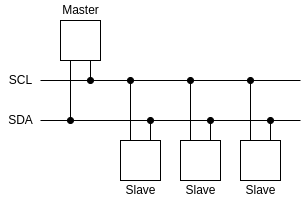PV198 Study Materials
Preliminaries
Theory
- Introduction
- GPIO
- Interrupts
- Timer
- PWM
- ADC
- Communication buses
- SPI
- I2C
- UART
Practical
I2C
I2C - Inter-Integrated Circuit is a common bus used for intra-board communication.
Properties
I2C is a bus, half-duplex, synchronous, and master/slave.
It works only over two signal wires:
SCL- wire withclockSDA- wire withdata
One transfer of data works in transactions in which messages made of bytes are sent over the SDA line.
This is clocked by the SCL line.
Each device has its address which has to be unique on the bus.
Each message contains the address of the target device.
We can have multiple masters. (Which is rare)

Addressing
I2C supports two addressing modes - 7bit and 10bit.
The addresses have to be unique.
In the case of MCUs, it is usually trivial to set up any address.
In the case of ICs, the manufacturers tend to give a basic address and some method for changing the last few bits of the address.
For example: the first 5 bits are fixed, and the last 2 can be varied by connecting two specific pins of IC to HIGH or LOW.
Bus
Let’s assume that we have only one master.
Any communication is initiated by the master, which sends at least one message in the transaction.
The first byte of the message contains the address of the slave device and the direction of communication (read/write).
Following that, based on the direction of communication:
Mastersends data overSDAwire, which is read by theslavethat detected its address.Slavewhich detected its address responds with data on theSDAwire.
Apart from the plain sending of data, bytes are confirmed by ACK bit from the other side of the communication.
Message
The logical content of the message looks as follows:

What data represents is content specific.
In the case of I2C, the common pattern is to have an abstraction of registers.
The slave device has a set of registers (usually with a size of 1 byte and at properly defined addresses).
Any interaction with the device works in terms of:
- Read
xbytes from a register at addressaddr. - Write
xbytes to a register at addressaddr.
This abstraction gives some shared form to the communication process, which translates into the following transactions:

Notice that the read of a register is made of two messages.
Usage
There are various devices or ICs, that use I2C for communication.
Out of all of those, two use cases stand out as curiosity: VGA and HDMI.
Both interfaces use I2C to allow control of devices over the cable or to transfer meta-information.